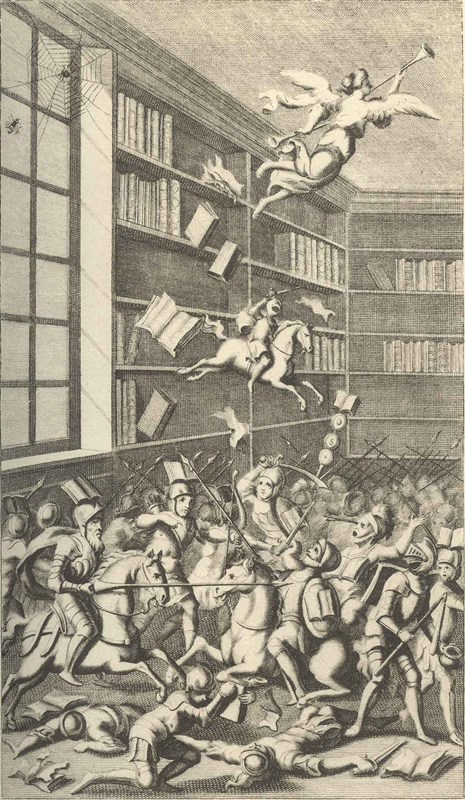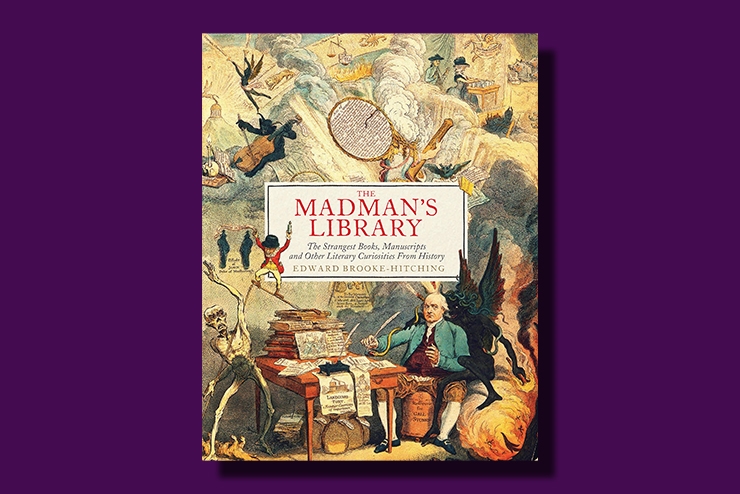The Madman’s Library: The Strangest Books, Manuscripts and Other Literary Curiosities From History
by Edward Brooke-Hitching
Chronicle Books
256 pp., $29.95
Books are the “emblem of civilization,” Edward Brooke-Hitching writes in a new book that explores the strange history of the medium. The earliest books were used to establish and uphold administrative, legal, and taxation powers, as well as dynastic legitimacy and moral, political, and religious order. Great libraries have frequently been aids to social stability. But if there has always been dry and pedantic “book learning,” thankfully there has also always been “bibliomania”—untrammeled authors who rejected all constraints of sense and taste, and books that even now burst brilliantly out of their bindings to assume enlightening and fantastical shapes.
The cover of The Madman’s Library features a 1790 aquatint by the British caricaturist James Gillray, depicting a grave gentleman at a library desk strewn with practical plans, while all around is pandemonium—capering cherubim, corpses, demons, explosions, flying papers, midgets, monuments, odd animals, and smoke—symbolizing mental and physical disorder behind a dignified and rational facade.
This splendid image illustrates the inherent anarchy of books—an idea famously treated by Jonathan Swift in his 1704 prolegomenon, “The Battle of the Books,” in which the ancient and modern volumes in a prestigious collection vie violently for shelf space. Similarly, in Jorge Luis Borges’ “The Library of Babel,” a short story about a seemingly infinite collection of mostly unintelligible tomes, the librarian narrator laments ruefully that “For every reasonable line or straightforward note there are leagues of insensate cacophony, of verbal farragoes, and incoherencies.”
Brooke-Hitching, who has previously published on outré geography, celestial mythology, and forgotten sports, is even more interested in literature’s oddest outcroppings—the world’s most crazed, gruesome, incomprehensible, monomaniacal, oddly made, strangely titled, and even toxic works, spanning millennia. This is a polished treatment of an ineffably interesting subject, well-informed and witty, almost too wide-ranging and copiously illustrated. There are countless books on literary curiosities, but even the most ardent bibliophiles are likely to find in this work new and beguiling examples of bookish bizarrerie.
Brook-Hitching opens with discussion of volumes that no longer exist, like the bejewelled edition of Omar Khayyam’s Rubaiyat made for the wealthy American Harry Elkins Widener, who packed it into his trunk before loading it and himself onto the Titanic. He also discusses books that were never books in today’s conventional sense, such as Roman “curse tablets,” Chinese oracle bones, Aboriginal message-sticks, Tibetan prayer wheels, Aramaic “devil-trap bowls” (bowls painted with text corkscrewing inwards to draw demons into captivity), the Incas’ quipu accounting system of knotted strings, a U.S. Civil War log written on a violin, a psychotic German’s testament inked onto her jacket, and xylothek books about species of trees made solely from the wood of that species.
Then there are manuscripts that have been radically repurposed as mummy wrappings, mitre-stiffeners, dresses for religious icons, or inscribed in the bodywork of a 1925 Type 40 Bugatti automobile. There are pistols and poison caches secreted inside books, a metal manual devised as a weapon by extremists of the German ’68er student protest movement, and, more socially beneficial, a commode in the form of a book winningly entitled A History of the Low Countries.
Also discussed by Brooke-Hitching are books bound by, fashioned from, or written in unusual (if often appropriate) materials. Among these are an edition of Paradise Lost bound in snakeskin and a volume of Gone With the Wind in a Confederate flag; bird books with illustrations made from feathers; and a book encased in rabbit pelt about a celebrated 18th century Englishwoman who claimed to have given birth to rabbits.
Probably the most piquant books are those bound within human hide, a practice anciently established, but surrounded by skin-crawling mystique. Jacobins were rumored to have run a secret tannery to process the epidermises of aristocrats, while copies of the French Constitution were bound in the skins of diehard democrats.
Even more grisly, when the body of the notorious Edinburgh body snatcher William Burke was dissected publicly after his hanging, blood from his head was used as ink, and some of his skin used to make a pocket book. Boston’s Athenaeum boasts the narrative confession of the 19th century Massachusetts highwayman James Allen, held together by Allen’s skin, and stamped in gold. The pioneering French writer and astronomer Camille Flammarion reputedly had a skin bequeathed him by its erstwhile occupant, a female admirer, and used it to bind a copy of his 1877 sci-fi novel, Les Terres du ciel. The present Iraqi government is the custodian of Saddam Hussein’s “Blood Qur’an,” allegedly written using the dictator’s blood.

Then there are cryptic books—messages in invisible ink or hidden inside eggs, books in codes that are even now unbroken, astrological and occultist manuscripts, riddle guides to alleged buried treasure, and books designed to deceive.
Literary hoaxes go back at least as far as the Stoics. More recent examples include the imposture of the faux-Formosan George Psalmanazar, who gulled 18th century London with his 1705 book An Historical and Geographical Description of Formosa—a “description” cobbled together from a variety of travel books having nothing to do with Formosa; the 1943 “Ern Malley” poems which humiliated Australia’s Modernist set; as well as nonsensical articles published in our own post-modernist era by serious scientific journals bedazzled by meaningless terminology.
There are books which are delightfully mistaken—medieval bestiaries, for example, or the “scientific” 1719 compendium of Indonesia’s psychedelic crustacea, including walking fish and mermaids. In the same vein one might mention Philip Henry Gosse’s Omphalos (1857), a work of natural history well known in its day, in which the author—a respected zoologist—argued that God had given Adam a belly button and planted fossils to test our faith. Nor should one overlook the American lawyer Pat Kelly’s 1988 masterpiece of disembodied intellect, If We Can Keep a Severed Head Alive.
There are obsessive catalogs, like the Libro de los Epítomes, a partial list of all the world’s known books assembled in the early 16th century by Ferdinand Columbus, second son of the great explorer, many of which have subsequently vanished forever. Less elevated are the anonymous Man of Pleasure’s Kalendar for the Year 1773, which details the attributes and specialties of Covent Garden’s prostitutes, and irate American physicist Harvey Einbinder’s 390-page pamphlet of 1964 detailing errata in the Encyclopaedia Britannica.
Also noteworthy are medieval missals with comical marginalia, a 14th century lawsuit undertaken by the Devil, Jesus’s last will and testament (found, rather unexpectedly, in Japan), books of dubious cures (eating rotten mice as a cure for bed-wetting), accounts of sky-pirates, dictionaries of thieves’ slang, detailed descriptions of Martian manners, and Victorian wallpaper sample books drenched in gorgeous green arsenic.
Two 1665 works show the breadth of bookish achievement: Athanasius Kircher’s Mundus Subterraneus, which mapped Atlantis and discussed cave-dwelling societies and the dragons that probably lived at Earth’s molten core; and Robert Hooke’s Micrographia, which literally changed the way we see the world, with its still magnificent drawings of the items he had seen through his shiny new microscope.
Brooke-Hitching’s survey of this infinitely expandable subject also gives due attention to examples of outsized and undersized books. Book dealers call miniature volumes Lilliputiana—like the 1878 edition of Dante’s Divine Comedy, a 500-page book just 1¾ inches high, set in a blindness-inducing typeface called “fly’s eye”—and giant volumes Brobdingnagiana, like the Yongle Encyclopedia commissioned by the Ming Emperor Zhu Di in 1403, which was 11,095 volumes long when work stopped in 1408, and remained the longest text ever written, until overtaken by Wikipedia in 2007.
The author concludes with a selection of strange titles, including the 10th century text In Praise of Bald Men or the 18th century’s The Adventures of an Irish Smock, Interspersed With Whimsical Anecdotes of a Nankeen Pair of Breeches, as well as modern works of doubtful taste, like James A. Yannes’ 2009 reference work Collectible Spoons of the Third Reich. Probably, many of these books are—to borrow the title of Sir George Compton Archibald Arthur’s 1914 book—Not Worth Reading, but what bibliophile wouldn’t want to have such masterpieces arranged along his shelf?
Last of all comes a sheet of punctuation marks, issued angrily in 1805 by the accidentally successful American entrepreneur, Timothy Dexter. It accompanied the second edition of his anti-elitist diatribe, A Pickle for the Knowing Ones, telling the many who had complained about the first edition’s lack of punctuation that they could do that job for themselves. His pawky pride and aggrieved defiance, so woefully misplaced and inadvertently entertaining, make this a perfect colophon to Brooke-Hitching’s collection, an emblem of our endless eccentricity and impatience with order, and the liberating nature of literature.

Leave a Reply